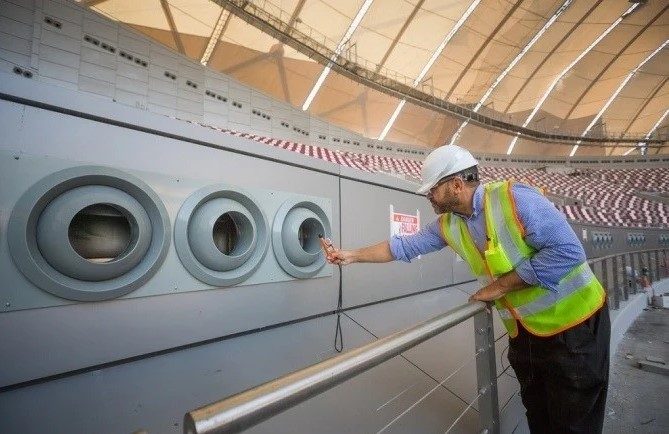The energy-efficient cooling technology installed at all World Cup stadiums will help combat Qatar’s heat during the 2022 sporting event.
Qatar has promised football fans and international spectators a cool, enjoyable and environmentally-friendly World Cup next year despite its heated weather.
While this may sound far-fetched to some, the FIFA World Cup 2022 organisers have already installed sustainable cooling technology in all eight football stadiums across the country to ensure no fan is left in sweats.
FIFA has already shifted the dates for the World Cup to allow Qatar to host during the winter season in a bid to avoid the extreme humidity and heat that come with the summer months.
For the first time, the tournament will be held from 21 November to 18 December 2022, when the average temperature in Qatar cools down to a breezy 18-24°C. This means the technology will assist to develop a “pleasant thermal environment during the tournament,” the Supreme Committee for Delivery & Legacy said.
After the Gulf state won the bid to host the event back in 2010, the organising body collaborated with Qatar University (QU) to design and inaugurate innovative cooling systems for venues.
The visionary behind the technology was Dr. Saud Abdulaziz Abdul Ghani, Professor of Mechanical Engineering at QU.
Read also: Sustainable cooling system at Al Janoub 2022 stadium ‘one of the best’ in the world
“The cooling technology we have in Qatar is an open example for the rest of the world to learn from,” said Dr. Saud.
“I am very proud that this technology – which originated here – can be adapted by other countries and businesses,” he added.
The cooling systems at each of the the stadiums are designed uniquely fit into each venue, which posed a challenge for Dr. Saud and his team.
“At each venue, we needed to cater for the players and spectators,” said Dr. Saud. “The players need cooler air than the spectators, as they are running around. Our challenge at each venue was to provide the correct technology and temperature for different areas of the stadium.”
The first project was installed at Khalifa International Stadium, which was already built prior to the World Cup preparations. “While at Al Janoub – the first venue to be built from scratch – it was incorporated at the design phase,” the SC said.
As for Al Thumama Stadium, scheduled to be inaugurated on Friday with the Amir Cup final between Al Rayyan and Al Sadd, the cooling technology system has been described as “advanced”.
“Here, we cool the air under the seats and recycle and purify it inside the venue,” Dr Saud said.
“Al Thumama also benefits from having a completely white exterior, thanks to its design replicating the gahfiya head cap, which reflects the sun and helps to keep the stadium cool,” the expert noted.
While environmentalists shudder at the thought of such technology, authorities in Qatar have taken due diligence to ensure the entire tournament is as green as possible. In this case, each system was designed to only cool certain areas at scheduled times.
All energy utilised across the eight stadiums is also transmitted from a solar panel farm located outside Doha and cool air is drawn back, filtered and redistributed across the stadium.
This major solar project was developed by QatarEnergy (formerly known as Qatar Petroleum) and Qatar Electricity & Water Company (QEWC).
Read also: US climate envoy praises Qatar’s commitment to environmental projects
“Our work on football stadiums is also benefiting food security in Qatar,” said Dr. Saud.
“By using the same technology on our farms, we have developed new methods to grow food in summer with less energy consumption. It fills me with pride to be able to use this technology for the benefit of the entire community.”
Qatar’s innovative cooling system is set to be one of the major legacies of the 2022 FIFA World Cup. And with the no patent on the technology, it means “anyone can benefit from its blueprint and adapt it accordingly without being charged,” the committee said.
So how does it work?
- Outside air is cooled through air conditioning fans that are powered by solar energy
- The cooled air enters the stadium through grills in the stands and large nozzles on the pitch
- Using an air circulation technique, cooled air is then drawn back
- The drawn back air is then re-cooled and filtered
- Once re-cooled and filtered, the recycled air is pushed out again into the stadium
With just over a year to kick off in Qatar, the SC is scheduled to announce its layers for its international match calendar next month.
32 teams will be participating in the World Cup after the qualifiers matches are completed, with Qatar automatically qualifying as the host nation.







